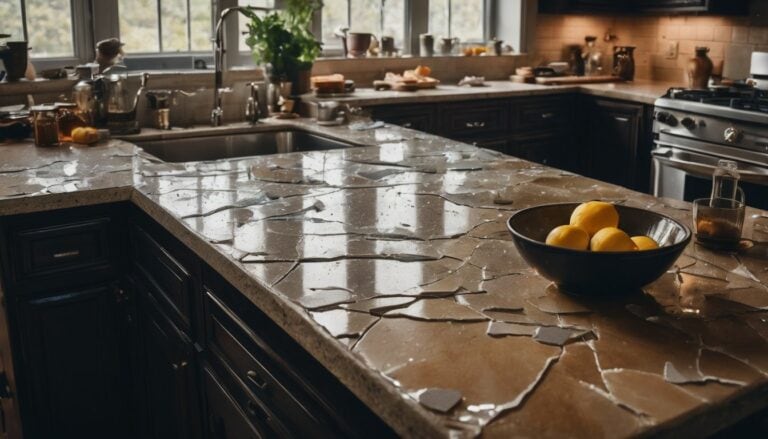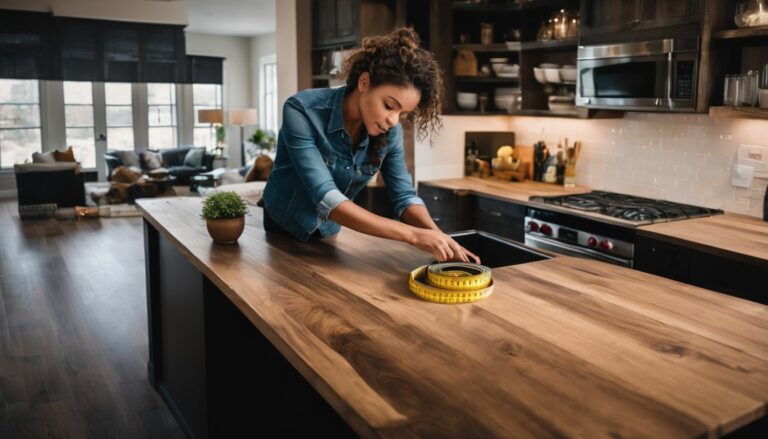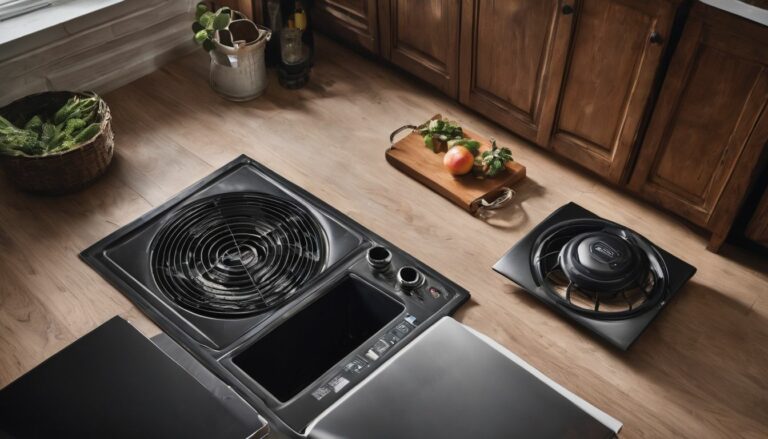Can I Use a Bathroom Vanity for A Kitchen Sink: The Ultimate Hacks
Does your kitchen cry out for a refresh, and you’re contemplating the idea of adapting a bathroom vanity as your new sink base? If that’s the case, you’re not alone. This clever swap is on many homeowners’ minds as they look to rejuvenate their kitchen space.
So, to answer the question, “Can I use a bathroom vanity for a kitchen sink?” The answer is absolutely Yes, but it’s important that you read our pros and cons section below, as well as other importan cosideration provided in this article before decide on what to do.
With comprehensive research and first-hand experience under my belt, I’ve learned that while switching these units is indeed possible, it demands careful planning due to their varying functionalities and design specifics.
Read on to discover how you can skillfully repurpose a bathroom vanity for your kitchen without compromising either style or utility! Let’s embark together on this creative home improvement adventure.
Key Takeaways
- Kitchen cabinets are taller, deeper, and made from sturdier materials than bathroom vanities.
- While it is possible to use a kitchen cabinet as a bathroom vanity, there are installation considerations and potential challenges to consider.
- Adjusting the depth of the cabinet and adding blocking at the rear can help convert a bathroom sink cabinet into a functional kitchen sink base.
- When choosing a kitchen cabinet for a bathroom vanity, consider size, materials that resist moisture, and style that complements your bathroom decor.
Differences Between Kitchen and Bathroom Cabinets

Dimensions
Kitchen cabinets are taller and deeper than bathroom cabinets. They often stand between 30 and 42 inches high. The depth is usually about 24 inches. But, bathroom cabinets have different sizes.
They are shorter with a height of around 24 to 30 inches. Bathroom units also have less depth, about 21 inches on average. For the width, it varies based on room size and storage needs.
Double-vanity bathroom cabinets can reach up to over 60 inches wide!
Durability
Durability is key in both kitchen and bathroom cabinets. In the kitchen, cabinets face grease and cooking fumes. These can hurt the cabinet’s look and how long it lasts. For this reason, you need to select a material that resists damage from these conditions.
Bathroom cabinets have a different battle to fight. Here, moisture and humidity are the big foes. They can make a cabinet warp or get damaged over time if not kept well. So, be sure to pick out cabinets that don’t let water in when used in bathrooms.
Regular care also helps keep your cabinets looking new for longer!
Material
Kitchen and bathroom cabinets are made from different stuff. The most often used materials for a bathroom vanity are solid wood, particle board, MDF (medium density fiberboard), and plywood.
In the kitchen, you’ll find cabinets that are sturdier to withstand heavy use. This is also why they cost more than those in the bathroom. For example, IKEA kitchen cabinets can be used as a base in your bath area if room size allows it — this could save you money! It’s crucial to choose materials that meet your style and wallet size but also last long enough.
A matching counter on top of your vanity can add charm to your room decor too!
Can Kitchen Cabinets Be Used in the Bathroom?

Yes, kitchen cabinets can be used in the bathroom, but there are some important factors to consider before making this decision.
Pros and Cons
Using a kitchen cabinet in the bathroom as a vanity has its own set of advantages and disadvantages. While it may offer ample storage and be an affordable option, there are certain installation considerations to be aware of.
| Pros | Cons |
|---|---|
| Kitchen cabinets are typically larger in size, providing ample storage space. | They may not fit properly in a bathroom due to their larger dimensions. |
| Kitchen cabinets offer the convenience of existing drawers. | The height and depth of kitchen cabinets can be challenging to deal with in a bathroom space. |
| It’s an affordable option as you can repurpose existing kitchen cabinets. | There are specific installation considerations due to the difference in the utility of kitchen and bathroom space. |
| The materials used in kitchen cabinets are typically durable and long-lasting. | You may have to adjust the depth or add blocking at the rear during installation. |
Other Considerations
Now, let’s talk about some other things to consider when thinking about using kitchen cabinets in the bathroom:
- Size and Dimensions: Bathroom cabinets are usually shorter and shallower than kitchen cabinets because they need to fit in smaller spaces. So, if you decide to use a kitchen cabinet, make sure it will fit properly in your bathroom.
- Materials: Kitchen cabinets are often made from materials that can handle moisture and humidity better than bathroom cabinets. So, keep in mind that using a kitchen cabinet in the bathroom may not be as durable over time.
- Style and Design: The style and design of kitchen cabinets might not match the overall aesthetic of your bathroom. Bathroom vanities often have more decorative features, such as carved details or unique finishes.
- Plumbing: Kitchen cabinets may not have the necessary cutouts or holes for plumbing fixtures like bathroom vanities do. You might need to make adjustments or hire a professional to ensure proper installation.
- Sink Compatibility: If you plan on using a kitchen cabinet as a bathroom vanity, make sure the sink you choose fits properly on top of it. Some sinks require special supports or reinforcements that might not be present in a kitchen cabinet.
How to Convert a Bathroom Sink Cabinet into a Kitchen Sink Base
To convert a bathroom sink cabinet into a kitchen sink base, you can start by adjusting the depth of the cabinet to accommodate the larger size of a kitchen sink. This may require removing or cutting down any excess materials at the back or sides of the cabinet.
Additionally, you will need to add blocking at the rear of the cabinet to provide proper support for the weight of a kitchen sink and plumbing fixtures.
Adjusting the Depth
To convert a bathroom sink cabinet into a kitchen sink base, you may need to adjust the depth. The standard depth for kitchen cabinets is usually 24 inches, while bathroom vanities are typically 21 inches deep.
Since stock cabinets used in kitchens or laundry rooms are 24 inches deep, they might be too deep for a bathroom vanity. But don’t worry! You can adjust the depth by cutting down the sides of the cabinet or using filler strips to narrow it down to fit your space perfectly.
This way, you can repurpose your bathroom sink cabinet and transform it into a functional and stylish kitchen sink base that meets your needs exactly.
Blocking at the Rear
To convert a bathroom sink cabinet into a kitchen sink base, you can add blocking at the rear of the cabinet. This means putting additional pieces of wood or another material at the back to bring it forward and accommodate the larger size.
By adding this blocking, you can adjust the depth of the cabinet to match that of a standard kitchen sink base, which is typically 24 inches deep. This modification allows for easier installation of a kitchen sink in your bathroom vanity without having to buy a new cabinet specifically designed for kitchens.
What to Consider When Choosing a Kitchen Cabinet for a Bathroom Vanity
When choosing a kitchen cabinet for a bathroom vanity, it’s important to consider the size and dimensions, materials used, as well as the style and design that will complement your bathroom space.
Size and Dimensions
When choosing a kitchen cabinet for a bathroom vanity, it’s important to consider the size and dimensions. Kitchen cabinets are usually around 35 inches in height without the top, while vanity cabinets are about 29-30 inches tall.
The height of kitchen cabinets can range from 30 to 42 inches, whereas bathroom cabinets typically fall between 24 and 30 inches in height. A standard bathroom vanity is approximately 31 inches high.
So, when selecting a kitchen cabinet for your bathroom sink base, make sure to take these measurements into account to ensure a proper fit.
Materials
When choosing a kitchen cabinet for a bathroom vanity, there are several materials to consider. Solid wood, particle board, MDF, and plywood are the most common options. These materials also often used in kitchen cabinets due to their durability.
Stainless steel is another material commonly used in kitchens for its strength and resistance to water damage. Rubberwood is also an option if you prefer something eco-friendly. It’s important to choose waterproof materials for bathroom cabinets to protect against moisture and water damage.
Keep these material options in mind when selecting a kitchen cabinet for your bathroom vanity project.
Style and Design
When choosing a kitchen cabinet for a bathroom vanity, there are a few important style and design factors to consider. First, think about the height of the cabinet. Kitchen cabinets are taller than bathroom vanities, so make sure you choose one that is the right height for your needs.
Next, look at the door style and configuration of the vanity. Consider whether you want drawers or doors, and if you prefer a single or double sink setup. Finally, think about the overall style and design aesthetic of your bathroom.
There are plenty of options available, from modern and sleek to traditional and ornate. So take your time to find a kitchen cabinet that fits well with your bathroom’s overall look and feel.
How to Make a Vanity Out of a Kitchen Cabinet
Making a vanity out of a kitchen cabinet is a great way to repurpose furniture and save money. Here are the steps to follow:
- Find a kitchen cabinet that has the desired dimensions for your bathroom space.
- Remove the top of the cabinet to create space for a sink.
- Measure and mark where the sink will be placed on the cabinet.
- Cut out the marked area using a jigsaw or other suitable tool.
- Install additional blocking at the back of the cabinet to support the weight of the sink.
- Attach any necessary plumbing fixtures and connect them to your existing plumbing system.
- Apply a waterproof sealant or paint to protect the cabinet from moisture in the bathroom.
Maintaining Granite Countertops for Bathroom Vanities
Maintaining granite countertops for bathroom vanities is easy and important to keep them looking beautiful and in good condition. Granite countertops are known for their water resistance, which makes them ideal for bathroom use.
To clean granite countertops, all you need is a mild cleanser and a soft cloth or sponge. Avoid using abrasive cleaners or scrub brushes that can damage the surface of the countertop.
Regularly wipe down your granite countertops with a mixture of warm water and a few drops of dish soap to remove any dirt or spills. Rinse thoroughly with clean water to ensure no residue is left behind.
It’s also important to dry the countertop after cleaning it to prevent any water spots from forming.
To maintain the longevity of your granite countertop, avoid placing hot pans directly on the surface as it can cause thermal shock and lead to cracks or discoloration over time. Always use trivets or hot pads when placing hot items on your countertop.
In addition to regular cleaning, you can enhance the shine of your granite countertop by applying a sealer every 6-12 months. The sealer will help protect the surface from stains and make it easier to clean.
By following these simple maintenance tips, you can enjoy the elegant design and durability of your granite bathroom vanity countertops for years to come.
The Debate: Vinyl or Hardwood Flooring for Bathroom Vanities
When it comes to choosing flooring for bathroom vanities, the main contenders are luxury vinyl and hardwood. Both these options offer distinct advantages and have been used extensively in different settings.
| Features | Hardwood | Vinyl |
|---|---|---|
| Durability | Hardwood floors are known for their timeless quality. They can withstand heavy appliances and cabinetry, including bathroom vanities. | Luxury vinyl, due to advancements in technology, is comparable to hardwood in terms of durability and longevity. |
| Appearance | Hardwood flooring adds a classic and sophisticated look to any bathroom. | Vinyl flooring has the ability to replicate the appearance of authentic hardwood and other manmade materials, providing a wide range of design options. |
| Popularity | While hardwood flooring has always been a popular choice, it is often more expensive and requires more maintenance. | Luxury vinyl plank or tile has become the go-to flooring choice for bathrooms in many places, including Alaska, due to its affordability and low maintenance. |
| Installation | It’s not necessary to install flooring before placing the bathroom vanity. In fact, heavy appliances and cabinetry, like a vanity, can be installed before laying down hardwood flooring. | Similar to hardwood, you can install the bathroom vanity before laying down vinyl flooring. This makes the installation process more flexible. |
It’s crucial to consider the type of flooring when searching for the perfect bathroom vanity. Both hardwood and vinyl flooring have their own appeal and functionality, so the choice comes down to personal preference and specific needs.
Expert Advice: Chat with a Cabinet Specialist
If you’re thinking about using a bathroom vanity for a kitchen sink base, it’s a good idea to get advice from a cabinet specialist. They can provide expert guidance on whether the conversion is possible and what steps you may need to take.
A cabinet specialist will have knowledge of different types of cabinets and their dimensions, which is important when considering if a bathroom vanity can be used for a kitchen sink base.
They can also help determine if any adjustments or modifications are needed to make the conversion successful. Consulting with an expert can save you time and ensure that your project is done correctly.
Conclusion
In conclusion, while it is possible to use a bathroom vanity for a kitchen sink base, it is not recommended due to differences in design and functionality. Bathroom vanities are typically shallower than kitchen cabinets and may not meet code-required clearances in a bathroom.
It’s important to consider these factors before making any modifications or conversions.
FAQs
Can I use a bathroom vanity for a kitchen sink base?
No, it is not recommended to use a bathroom vanity for a kitchen sink base as they are designed differently and may not have the necessary features or dimensions required for a functional kitchen sink installation.
What is the main difference between a bathroom vanity and a kitchen sink base?
The main difference between a bathroom vanity and a kitchen sink base is their design and functionality. A bathroom vanity is typically smaller, with storage space for toiletries, while a kitchen sink base is larger, designed to house plumbing connections and provide support for the kitchen sink.
Are there any safety concerns if I use a bathroom vanity as a kitchen sink base?
Using a bathroom vanity as a kitchen sink base can pose safety concerns such as potential water damage due to inadequate sealing or improper drainage connections. It’s best to choose the appropriate furniture specifically designed for its intended purpose.
What is the fundamental difference between kitchen cabinets vs bathroom cabinets?
The fundamental difference between kitchen cabinets and bathroom cabinets lies in their design and functionality. Kitchen cabinets are specifically designed to store and organize kitchen essentials such as cookware, utensils, and food items. They are typically larger and more spacious to accommodate the various items needed in a kitchen. On the other hand, bathroom cabinets are designed to store personal care products, towels, and other bathroom essentials. They are usually smaller in size and may have more compartments for organizing toiletries. Overall, the main difference is in the purpose and size of the cabinets, catering to the specific needs of each room.
How do the design and aesthetics of kitchen cabinets differ from bathroom cabinets?
The design and aesthetics of kitchen cabinets differ from bathroom cabinets in several ways.
- Functionality: Kitchen cabinets are designed to store and organize a variety of items such as cookware, utensils, and food items. They often have multiple shelves, drawers, and compartments to accommodate different sizes and types of items. On the other hand, bathroom cabinets are primarily used for storing toiletries, cleaning supplies, and personal care products. They typically have fewer shelves and drawers since the items stored in a bathroom are generally smaller in size.
- Materials: Kitchen cabinets are often made of durable materials such as solid wood, plywood, or medium-density fiberboard (MDF) to withstand the heavy use and exposure to moisture and heat in a kitchen. Bathroom cabinets, on the other hand, are usually made of moisture-resistant materials such as laminated or thermofoil surfaces to protect against water damage.
- Style and Design: Kitchen cabinets come in a wide range of styles, finishes, and colors to match different kitchen designs and personal preferences. They can be traditional, modern, or transitional in style, and may feature decorative elements such as moldings, glass doors, or ornate hardware. Bathroom cabinets, on the other hand, tend to have a simpler and more streamlined design to create a clean and functional look in the bathroom.
Overall, while both kitchen and bathroom cabinets serve the purpose of storage, their design and aesthetics are tailored to meet the specific needs and requirements of each space.
What materials are commonly used in kitchen cabinets versus bathroom cabinets?
Common materials used in kitchen cabinets include wood, plywood, particleboard, and medium-density fiberboard (MDF). These materials are chosen for their durability and ability to withstand the heavy use and moisture typically found in kitchens.
On the other hand, bathroom cabinets are often made from materials such as plywood, MDF, or moisture-resistant particleboard. These materials are selected for their ability to resist moisture and withstand the humid environment of bathrooms.
Can I use kitchen cabinets in the bathroom, or vice versa?
No, it is not recommended to use kitchen cabinets in the bathroom or vice versa. Kitchen cabinets are specifically designed for the kitchen environment, where they are exposed to heat, moisture, and grease. Bathroom cabinets, on the other hand, are designed to withstand the humidity and moisture present in the bathroom.
Using kitchen cabinets in the bathroom may lead to damage and deterioration due to the different environmental conditions. It is best to use cabinets that are specifically designed for the intended space to ensure their durability and functionality.
Does the installation process differ between kitchen cabinets and bathroom cabinets?
Yes, the installation process can differ between kitchen cabinets and bathroom cabinets. While both types of cabinets are typically mounted to the wall, there are some key differences. Kitchen cabinets often have a more complex installation process due to the need for additional support and weight-bearing capabilities.
This is because kitchen cabinets are designed to hold heavier items such as dishes, pots, and pans. Bathroom cabinets, on the other hand, are typically lighter and may not require as much support. Additionally, bathroom cabinets may need to be installed in areas with plumbing fixtures, which can add another layer of complexity to the installation process.
Therefore, it is important to follow the manufacturer’s instructions and consult with a professional if you are unsure about the installation process for either type of cabinet.
Are Kitchen and Bathroom Cabinets Different?
Kitchen and bathroom cabinets are different in terms of their design and functionality. While both types of cabinets are used for storage, kitchen cabinets are typically larger and more durable to accommodate heavy pots, pans, and appliances. They are also designed to withstand the moisture and heat that can be generated in a kitchen environment.
On the other hand, bathroom cabinets are often smaller and may have built-in features such as mirrors or medicine cabinets. They are designed to withstand the moisture and humidity of a bathroom. Overall, kitchen and bathroom cabinets serve different purposes and are tailored to the specific needs of each room.
Which Types of Kitchen Cabinets Work Best in Bathrooms?
When it comes to choosing kitchen cabinets for bathrooms, it is important to consider the specific needs and requirements of the space. While kitchen cabinets can be used in bathrooms, there are certain factors to consider. Firstly, the cabinets should be made of materials that can withstand the moisture and humidity typically found in bathrooms.
Additionally, the cabinets should have a design and style that complements the overall aesthetic of the bathroom. It is also important to ensure that the cabinets provide sufficient storage space for bathroom essentials. Therefore, it is recommended to choose cabinets specifically designed for bathrooms to ensure they are suitable for the environment and meet the functional and aesthetic needs of the space.
Can You Use a Kitchen Cabinet as a Vanity?
Yes, it is possible to use a kitchen cabinet as a vanity. Many people repurpose kitchen cabinets as bathroom vanities due to their sturdy construction and ample storage space. However, it is important to consider the dimensions and design of the cabinet to ensure it fits well in the bathroom and meets your specific needs. Additionally, modifications may be required to accommodate plumbing fixtures such as sinks and faucets. It is recommended to consult with a professional to ensure proper installation and functionality.







